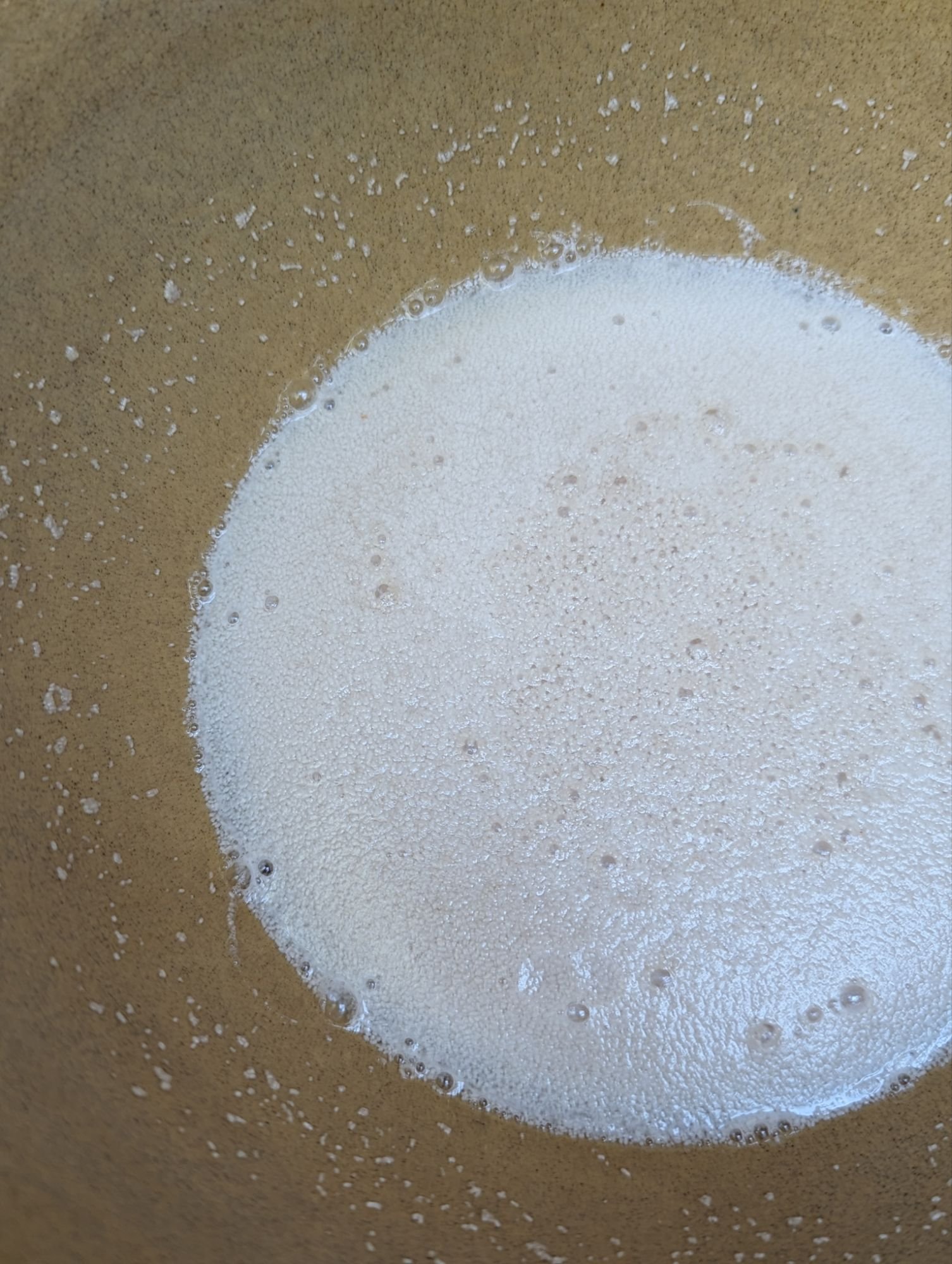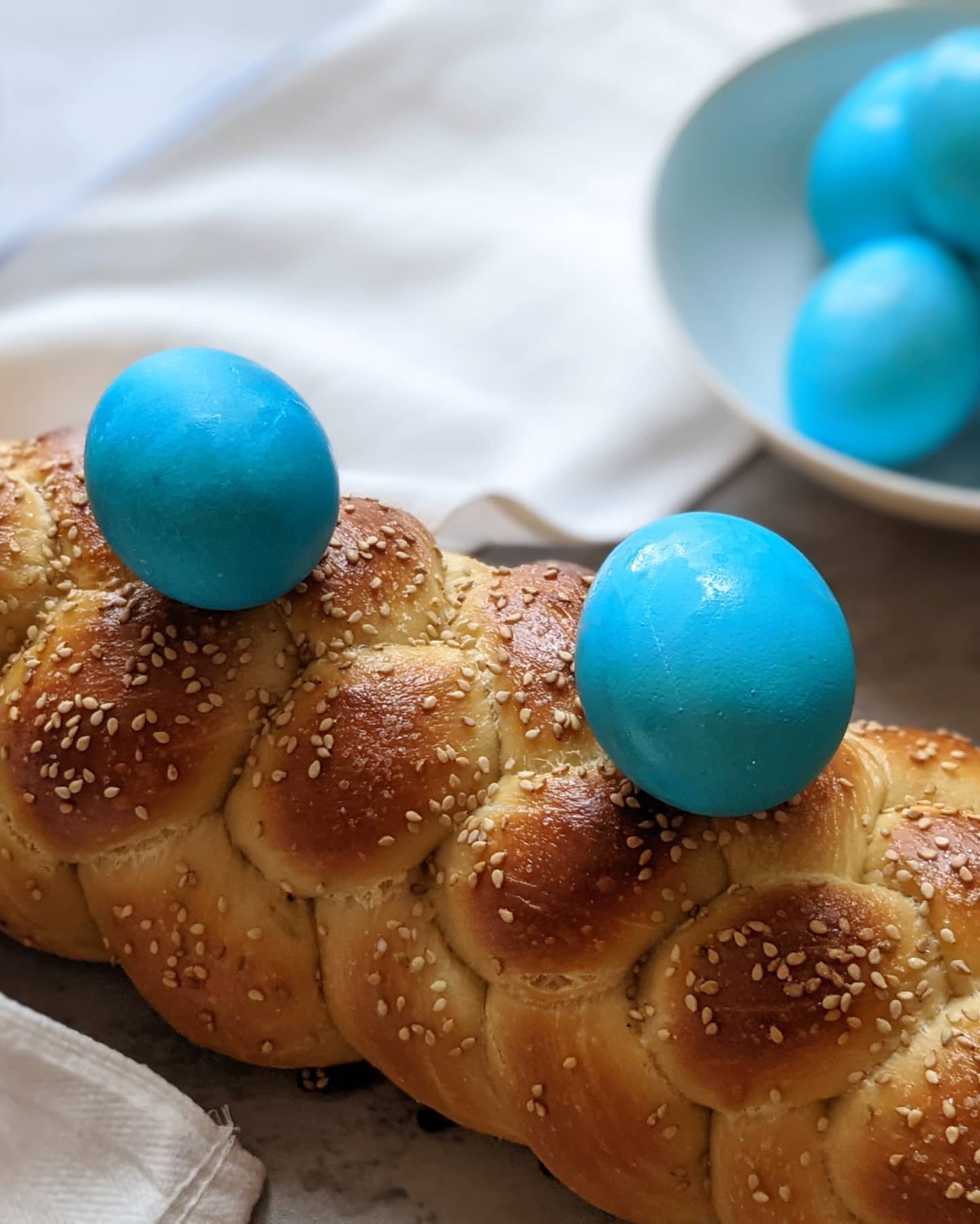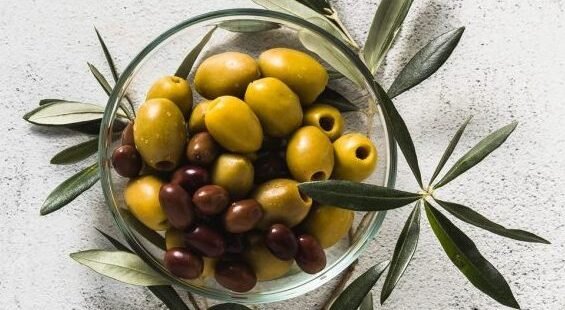Koulourakia & Tsoureki (Baking Tips & Tricks)
Want to learn the tips and tricks for making fluffy tsoureki or discover the many flavors of koulourakia? Here at Kouzounas Kitchen, we’ve got you covered! Chef Krystina has been baking these beloved Greek classics since the age of 12. Read on for the full tips and tricks!

Koulourakia (Greek Easter Cookies) Baking Tips
Let’s kick things off with some delicious koulourakia cookies!

Koulourakia:
What are these delicious classic Greek cookies? They’re beautifully buttery with a lovely crunch. Usually flavored with orange or lemon zest and a hint of ouzo, they’re the perfect cookie to dunk in coffee!
Infused Koulourakia:
Yes, you can add some fun twists to your Koulourakia cookies!
Here’s a few ideas for you:
- Greek coffee infused
- Blood orange zest & vanilla
- Fun friendly kid Koulourakia! Add a handful of sprinkles or perhaps Easter chocolate candies to the mix.
- Cranberry or currants with orange zest is a really good mix too!
- Adding zest is the perfect addition to these cookies too! Orange, lemon zest, and mandarin zest. Adding vanilla bean is great too.
- Ouzo works really well if you spray it on a few minutes before you remove the cookies from the oven. Anthonero works great too!
- I have a new one loading as I am typing this! Stay tuned in.
Toppings:
Sliced almonds, sesame seeds, or sprinkles. Some people like to add demerara sugar over the top for a sweet crunch.
You can seriously make any type of koulourakia!
Other milk options:
You can use non-dairy milk such as oat milk, coconut, or almond. I made koulourakia with oat milk, almond milk, and coconut milk. All of these options work well.
When you add the milk to the mixture don’t worry if the mixture breaks a bit. It will bind together once you add the flour mixture.
Shapes:
We have many different shapes for koulourakia, with the most common being the braided shape below. I’ve included a photo of my “not-so-nice” handwriting, lol!

Braided koulourakia:
You take about a 6-7 inch rope and make an upside-down u shape then take one side wrap over the other side and make a twist shape.

A twisted round shape:
Do the same as the braided shape but take both ends and mold together to create a beautiful round twist.
**Don’t mind my very OLD pastry brush and the bristles here!

The ‘S” shape:
Take a rope about 6-7 inch long and on each end coil the rope towards each other to make an “s” shape.
The “Snail” shape:
Take a rope about 6-7 inches long and roll the rope to form a coiled shape similar to a snail.
Try out our other koulourakia recipes here:




—————————————————————————————————–
Baking Tsoureki (Greek Easter Bread) & Tips

Tsoureki Tips:
Ingredients:
Have the eggs and butter at room temperature before starting the dough process—this will help the dough come together nicely. It’s best to have all your ingredients prepared before you begin baking. Make sure you have a large enough surface and a stand mixer or bowl to work with. I include a variety of tsoureki recipes—some made with olive oil and others with butter.
Aromas:
You can flavor your tsoureki with many wonderful ingredients, but my favorites are lemon, orange, mandarin, cardamom, vanilla, mastiha, and mahlepi. Mastiha and mahlepi are the most common flavors for this type of bread. Mastiha is a resin that comes from the trees on the island of Chios. It has a really unique aroma and taste, almost with a pine-like flavor. Mahlepi is a powder made from the seeds of a wild cherry tree, giving it a slightly sweet, floral, and almond-like flavor.
If you want to make stuffed tsoureki, I always enjoy using a Nutella and cardamom mixture. You can find the recipe below.
You can make what I like to call the ” Terkenlis” tsoureki. Which is stuffed chestnut filling or with chocolate filling and then you cover your tsoureki with chocolate over the top. Yes, it is good but very sweet! See our very own version of this tsoureki below.
We used raspberry or strawberry jam in our tsoureki! It is really good!
Almond paste is AMAZING in tsoureki! If you haven’t tried that please do. See the photo below.

Yeast:
Make sure your yeast is nice and bubbly and active. If the yeast and liquid don’t create a bubbly mixture, then the yeast isn’t active. See photo below.

Dough:
Place the dough inside a warm bowl to kickstart the first rise. It is very IMPORTANT you see the dough double in this first rise. Try adding a warm towel over the top of the bowl and place it in the sunlight so you can kickstart the rise.
Make sure you spray the plastic wrap with oil or butter. This will help prevent the dough from sticking. 🙂
Rise Times:
It is very CRUCIAL to let the dough rise at least 3 times. I say this so you get a nice fluffy texture, and your bread is soft. If you rush the process, the tsoureki won’t be fluffy. You should rise the dough on the first stage for about 1 1/2 to 2 hours, then the 2nd rise for about an hour, and the 3rd rise for about 30 minutes or so. Once your dough has tripled in bulk on the first rise, then you are ready for the 2nd rise.
Cold Rise:
You can do a cold rise overnight, and that results in a beautiful texture. I found that a cold rise results in a fluffy texture. If you do a cold rise, then remove the day of baking an hour before.
Braiding & Shaping:
We all know the traditional three-braid shape, but how about other braids? The three-strand shape is simple—it’s like braiding your hair. Take three strands, mold them together at the very top, then place the farthest left strand over the middle, and the farthest right strand over the middle.
You can make a three-braided shape and then form it into a round loaf, which is beautiful. Now, the question is, where do we put the eggs? If you want to place eggs inside the round loaf, take a small amount of dough and cover the hole. Then, add the egg in the center. This prevents the eggs from cracking while the bread is baking.
Bake Times:
So far all the years I have been baking tsoureki I found out a key trick! Go slow and steady with your bread. Bake at 300 degrees for approximately 50-60 minutes. This will result in a beautiful golden brown color and the bottom of your tsoureki should be perfect and not burnt!
Parchment Paper:
Double up on your parchment paper! Tsoureki tends to burn on the bottom so please follow this step! You can even triple the parchment paper if you like.
Olive Oil or Butter:
To be honest I love both recipes! I find both of the tsourekia to be nice and fluffy! Try each one and let me know what you love.
How To Revive Dry Tsoureki:
You can either revive the bread in the oven at a low temperature covered in foil or pop inside the microwave for a few seconds. You can try out my AMAZING tsoureki French toast.
How to Freeze & Thaw:
To freeze tsoureki I simply wrap my breads inside plastic wrap many times, to ensure it is well covered. You can then use a plastic bread bag to cover the tsoureki and freeze. I normally freeze mine for only up to 1 month.
To thaw tsoureki remove it from the freezer and let it sit out on the counter for at least a few hours before serving. If you can find some direct sunlight, then place the loaf or loaves in the light.
Different Tsoureki Recipes:
See our fluffy tsoureki below made with olive oil!


Fluffy Tsoureki (made with olive oil)
Servings: 4 medium loaves or 2 large loaves
Ingredients:
- 3 1/2 teaspoons of dry yeast (make sure your yeast is good)
- 2 tablespoons of sugar (I use organic sugar)
- 1 3/4 warm water (make sure the water isn’t too hot)
- 1/2 cup + 3 tablespoons of organic sugar
- 1/2 cup of olive oil ( I use a light extra virgin olive oil)
- 5 eggs at room temperature
- 1 tablespoon of salt
- 8 1/2 cups of all-purpose flour
- 1 tablespoon of mahlepi & mastiha
- 1 mandarin & 1 lemon (reserve zest)
- 2 teaspoons of vanilla bean, reserve seeds
- Optional: Sesame seeds or sliced almonds
- Optional: sprinkle sugar to bake
Method:
- In a large bowl dissolve the yeast with the sugar and water. Mix with a wooden spoon, and set aside. Once the mixture is bubbly and foamy pour into a mixer bowl.
- Attach the dough hook, and pour the oil while the mixer is running. Add the eggs one egg at a time, and then add the rest of the sugar.
- On parchment paper, mix the flour, salt, lemon, mandarin, vanilla, mahlepi, and mastiha. Mix to combine.
- While the mixer is running add the flour in 3 increments. This is a ton of flour, so I recommend using a large mixing aid, otherwise, mix by hand in a large bowl. If mixing by mixing aid, knead for about 4 minutes at medium speed.
- If mixing by hand, once the dough forms, turn the dough onto a floured surface and knead by hand. Knead until the dough is smooth. Place dough into a large bowl, lightly greased with olive oil.
- Cover the dough with plastic wrap and then cover it with a towel. I place the bowl usually outside in a warm place, and I let it rise until tripled in bulk. Usually, it takes about 1 and 1/2 hours for me.
- Punch down the dough and let it rise again until doubled in bulk.
- Form the dough into desired braids and then let rest for 30 minutes or so covered. (See shapes) Prepare a baking sheet with 2 sheets of parchment paper.
- Eggwash the dough before you place it into the oven, and then top it with sesame seeds or sliced almonds. Sprinkle with sugar, and then bake in the middle rack at 300 degrees F or 148 Celsius for about 50-65 minutes or until golden brown. Everyone’s oven baking times are different so check to see how your bread is doing at 45 minutes. Then adjust if needed to bake more. You don’t want to overbake this bread as that results in a dry loaf.
- Once you remove the bread from the oven, let it cool on a wired rack, and then serve.
- You can freeze this bread, and make sure you cover it tightly with plastic wrap and then a plastic bread wrapping bag. If you don’t freeze the bread it’s usually good for up to 3-4 days. See my notes above. e





I hope these tips help with your baking! If you try our recipes, please tag us using #CookingWithKouzounasKitchen. Wishing you a beautiful Orthodox Easter filled with joy and love. May you enjoy precious moments with your loved ones, and may you be blessed with good health!



Your recipe sounds amazing and I will definitely try it! Could you please specify the units for water and sugar? Efcharisto poli!
Hi! Thank you for stopping by and enjoying my recipes. 🙂 Yes, for which recipe would you like the units? Thank you!!
At what point in the process can you freeze the dough, and how do you defrost and bake it afterward?
With the egg wash, i do it 3 times, once as soon as braided, a second mid prove and a third just before going in the oven. Gives a nice glossy coat and browns beautifully.
Hey thanks for your comments mate. If you are using the “olive oil” method then egg wash once is perfect for a beautiful golden color. I always egg wash before going in the oven, but feel free to do it anyway you like.
Making these since I was 15 so I love sharing my methods from the years. 🙂
Happy baking!